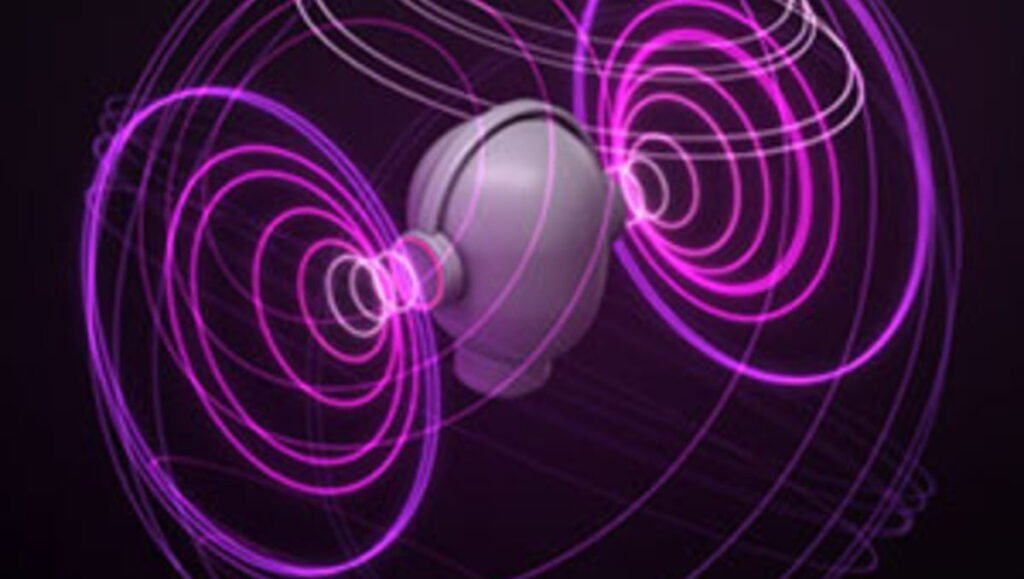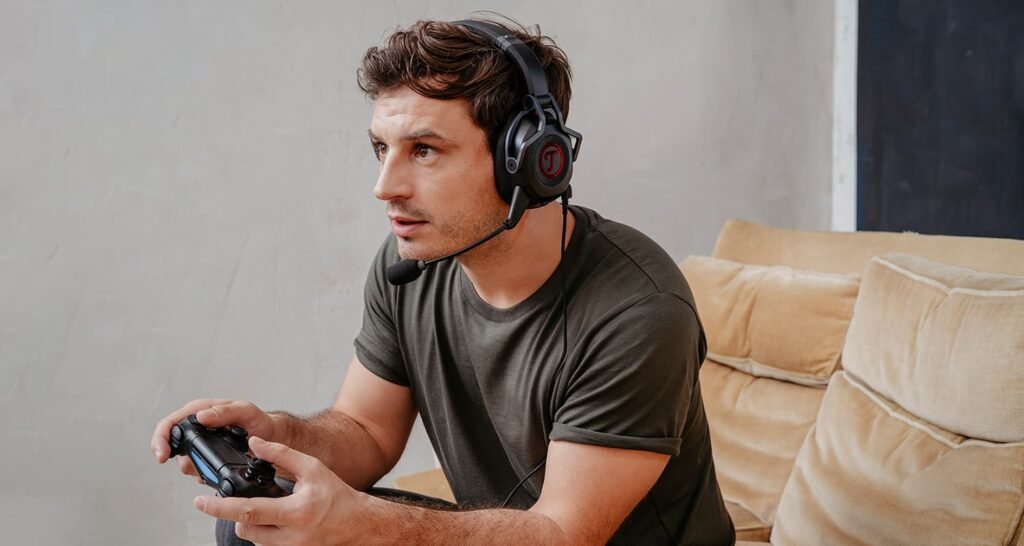Dolby Atmos is a surround sound format that started in movie theaters. It was built to place sounds in a three-dimensional space, not just around the listener but also above and below. Unlike traditional surround systems that assign audio to fixed channels, Atmos treats each sound as an object. That means it can move independently in 360 degrees.
Later, the same concept was adapted for home theaters, then for games and headphones. I first heard Atmos in a cinema during a movie with heavy rain effects. It wasn’t just left and right — the sound felt like it came from above my head. That same idea is now built into gaming headsets, PCs, and consoles using a version made for headphones.
With headphones, Atmos takes that object-based mix and converts it into something called binaural audio. It’s designed to trick your brain into thinking sound is happening all around you, even though it’s coming from two speakers close to your ears.
How Dolby Atmos Works on Headphones
When you play a Dolby Atmos-enabled game or movie with headphones, the system uses a head-related transfer function — or HRTF — to simulate how sound arrives at your ears in real life. The software analyzes the position of each sound object and adjusts it with filters that mimic how your head, ears, and shoulders shape incoming sound.
Nope. Any regular stereo headphones will work. The heavy lifting is done by the Atmos software, not the headphones themselves.

I tested this on a Windows PC using the Dolby Access app. With regular stereo, the sound felt flat and tight. When I turned Atmos on, the same scene opened up. Footsteps had more distance. Voices moved as characters walked across the screen. The biggest shift came from sounds above or behind — something I usually don’t get from stereo output.
It’s not a separate audio file. It’s a rendering system. You still use the same headphones, but the processing adds direction and space.
Atmos vs Virtual Surround (Dolby Headphone)
Before Atmos, surround sound on headphones was mostly based on channels. Dolby Headphone was one of the early systems that used virtual surround — it took a 5.1 or 7.1 mix and made it sound like it was around you. It worked, but it was fixed. The channels stayed in the same place, and movement wasn’t always natural.

Atmos changed that by using objects instead of channels. That means a single sound — like a gunshot or voice — can move freely in all directions. The system decides where it should go, not based on a speaker layout, but based on position in space.
I tested both back to back in the same game. Dolby Headphone gave me a wide soundstage, but it felt flat. Sounds were spread around me but didn’t move much. With Atmos, the same game felt more alive. I could hear footsteps start far off, move behind me, and pass to my left. It felt less like simulated surround and more like I was inside the scene.
Gaming Benefits of Dolby Atmos
Atmos helps the most in games with a lot of spatial sound cues. I tried it first in a campaign shooter. The difference was clear in the first few minutes. Gunfire didn’t just come from left or right — it had depth. Grenade sounds landed with space around them. Dialogue felt like it came from the environment, not just the headset.

The best example was in a stealth section. I could hear enemy movement from a distance, and the angle felt accurate. It made tracking sound part of the strategy, not just an extra effect.
In open-world games, it worked the same way. Wind moved across scenes, and the way sound bounced off walls gave more presence to large spaces. I used it in headphones that weren’t labeled as “gaming” — just regular stereo — and it still made a difference.
Platforms That Support It
Atmos for headphones is available through the Dolby Access app. I installed it on Windows 11, and the setup was simple. It also works on Xbox consoles, both Series X and Series S. You don’t need special headphones — the app handles everything in software.
After the install, I tried it with three games that already had Atmos support. The app gave a clear toggle, and most games auto-detected the format. Some titles needed a restart, but once it was on, I didn’t have to adjust anything else.
I also tried it on a laptop using basic wired earbuds. Even without high-end gear, the effect was still noticeable. The software license was a one-time purchase. After that, it stayed linked to my Microsoft account, so I didn’t need to pay again when I switched devices.
Pros and Cons of Atmos on Headphones
Pros
One of the big draws of Dolby Atmos for headphones is the sense of space it adds. Sounds don’t just come from the left or right — they feel like they’re coming from above, behind, even below you. That might sound like marketing talk, but in practice, it does make a difference. In games, for example, you’ll often pick up on small cues earlier — footsteps in the next room, gunfire from a rooftop, or the hum of something flying overhead.
It’s also nice that you don’t need special headphones to use it. Regular stereo headphones work just fine. The only real requirement is a license for the Atmos software. On PC and Xbox, that’s a one-time purchase — around $15 — and once it’s activated, you’re set. For what it adds, most people would say it’s worth the price.
People who’ve used it for a while say it can make games and movies feel more immersive without being too over-the-top. It doesn’t try to fake surround sound with echo or reverb — it just makes things feel a bit more alive. You hear sounds placed in a more natural way, like you’re inside the scene instead of just watching it.
Cons
There are a few things to keep in mind, though. First off, you do need to buy a license. It’s not built into Windows or Xbox by default. That’s not a huge deal, but it’s worth knowing upfront.
Also, depending on what you’re listening to, Atmos might not always sound better. With some music, for example, the processing can change the way things were originally mixed. You might notice a bit of “color” added to vocals or instruments, especially if the source wasn’t designed for spatial audio.
And not every game or app supports Atmos out of the box. Some need updates or manual settings tweaks. So even though the feature works system-wide, the results can vary. Sometimes it sounds amazing. Other times, not so much.
User Experiences & Feedback
Most people who try Dolby Atmos for headphones say it makes a clear difference, especially in gaming. On Reddit and the Steam community, you’ll find plenty of posts from players who use it daily. They mention better clarity when tracking footsteps, more precise positioning for gunfire or explosions, and a stronger overall sense of “space” in their audio.
One common example is in first-person shooters — players say they can tell where enemies are coming from more quickly, even if they’re above or below. That kind of spatial cue isn’t always possible with standard stereo.
That said, not everyone is convinced. Some users mention that in certain games or scenes, Atmos can sound a little muddy — like it’s trying too hard to spread things out. Others don’t love the idea of having to pay extra for a feature that feels like it should be included.
Still, if immersion is what you’re after, most agree that Atmos delivers more often than not.
Atmos vs Other Spatial Solutions
Atmos isn’t the only virtual surround system out there. DTS Headphone:X and Windows Sonic are both alternatives, and they each have their own approach. Sonic is free and built into Windows. DTS is another paid option, though usually bundled with some gaming headsets.

The main difference comes down to how sound is processed. DTS and Sonic use virtual surround — they simulate audio channels around you. It works, but the placement can feel locked into a “circle” around your head. Atmos, on the other hand, uses object-based audio. Instead of fixed positions, it treats each sound as its own moving point in 3D space. That’s why Atmos can make things feel more “above” or “below” you, not just left or right.
In head-to-head tests, Atmos usually comes out on top for directional accuracy and realism. But there’s no single winner — it depends on the game, the headphones, and your own preferences. Some people actually prefer DTS for action games, saying it sounds more “aggressive” or punchy.
Is Dolby Atmos lossless?
No. When used on headphones, Atmos is a spatial rendering system — not a high-res audio format. It processes audio in a way that helps with positioning, not raw quality.
Do I really need it?
That depends. If you mostly play games or watch movies and want better immersion, then yes — it’s a solid upgrade. But if you mostly listen to music or stick with stereo content, you might not notice a huge difference.
Do I need special headphones?
Nope. Any regular stereo headphones will work. The heavy lifting is done by the Atmos software, not the headphones themselves.